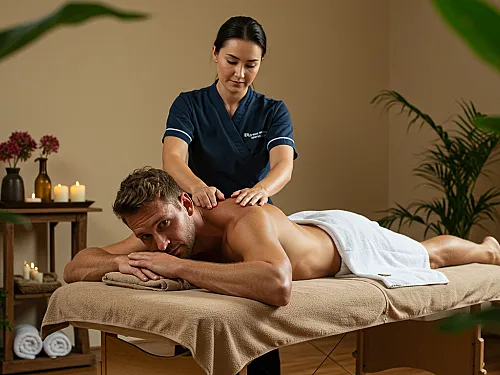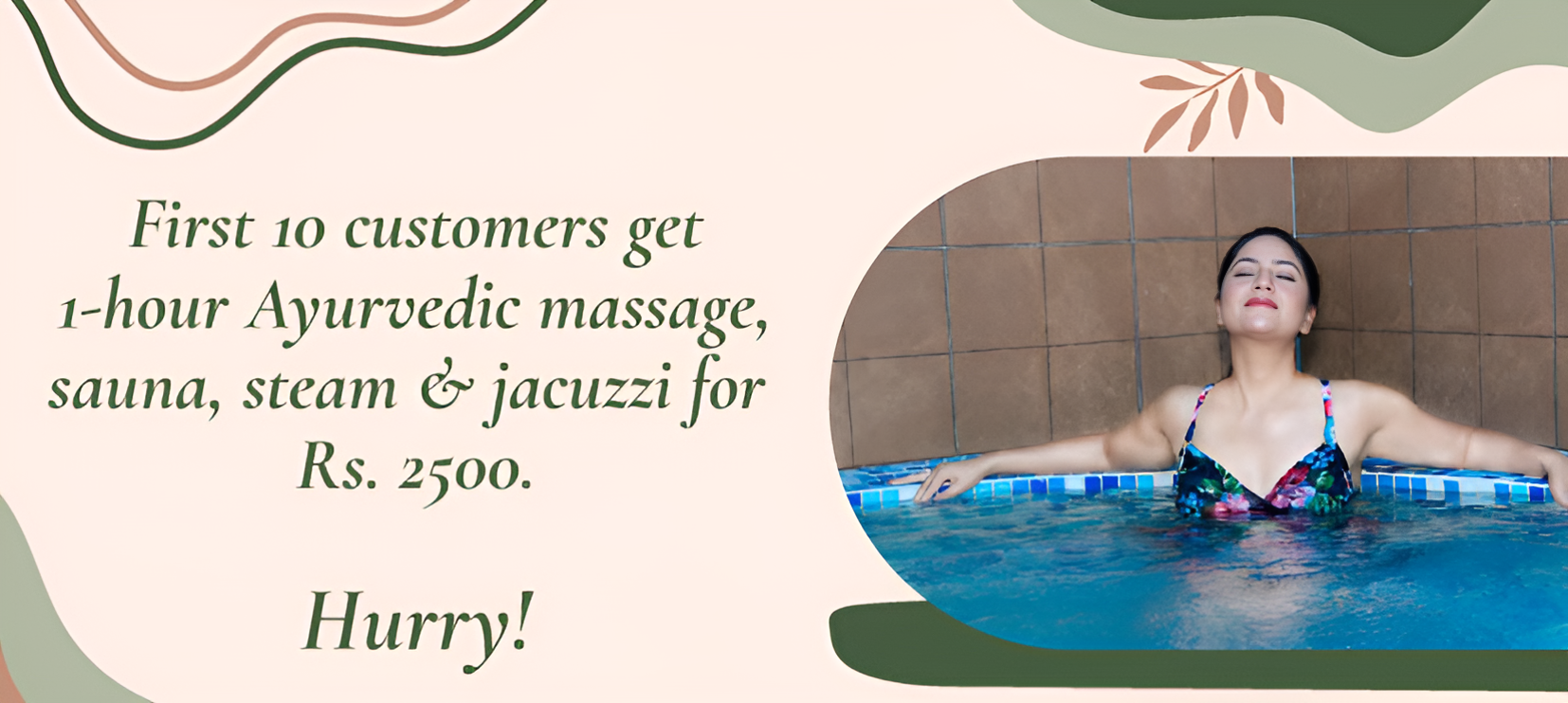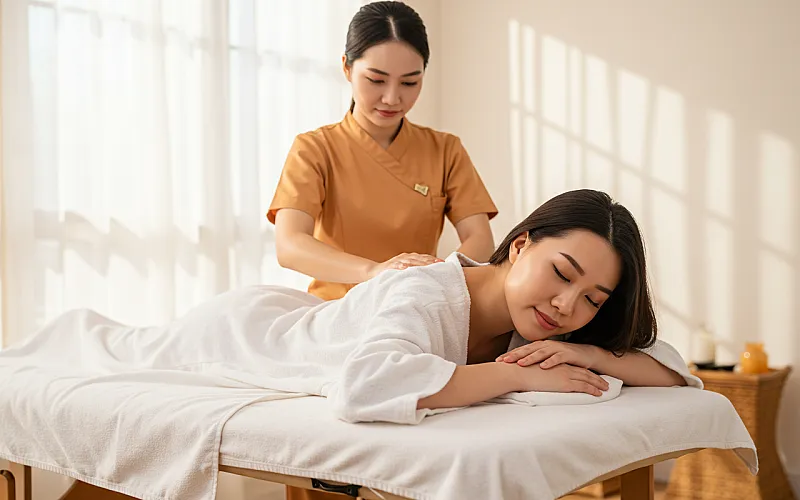
Best Trekkers Massage Therapy in Nepal for Post-Hike Recovery
March 24, 2025
Published on May 25, 2025
Nepal’s towering peaks often steal the spotlight, yet its wellness traditions remain an equally powerful draw. From ancient herbal baths once reserved for royalty to today’s boutique sanctuaries overlooking snow-capped ranges, the country offers a restorative path for tired bodies and busy minds alike. Ready to learn how local ritual merged with global wellness trends? Read on, then plan a restorative escape with Real Therapy Spa.
A spa is a place where trained therapists employ water, natural oils, heat, herbs, and touch to improve physical comfort and mental calm. The setting removes daily distractions, letting guests focus on self-care.
| Category | Treatment | One-Line Overview | Key Benefits | |
| Massage-Based | Swedish Massage | Light-to-medium pressure glides along muscles. | Relaxation, blood flow, mild pain relief | |
| Deep Tissue Massage | Slow, firm strokes reach deeper muscle layers. | Breaks scar tissue, eases chronic tension | ||
| Himalayan Hot Stone | Warm salt stones loosen rigid areas. | Intensive muscle release, mineral absorption | ||
| Traditional Nepali Massage | Herbal oils plus acupressure rooted in local healing. | Balances energy, reduces fatigue | ||
| Ayurvedic Abhyanga | Warm herbal oil applied in rhythmic strokes. | Nourishes skin, supports dosha balance | ||
| Thai Yoga Massage |
| Improves flexibility, joint mobility | ||
| Reflexology | Focused foot or hand pressure on reflex zones. | Digestive support, headache relief | ||
| Water- & Heat-Based | Hydrotherapy Pool | Warm jets massage muscles inside a pool. | Joint relief, lymph movement | |
| Moist heat infused with local herbs. | Detox through sweat, respiratory ease | ||
| Vichy Shower | Overhead jets cascade while lying on a table. | Boosts circulation, exfoliates skin |
Massage and hydrotherapy loosen tight muscles, boost blood flow, and aid toxin removal. Quiet surroundings lower heart rate, which in turn calms racing thoughts. Many visitors report lighter moods, fewer aches, and steadier sleep patterns after only one visit.
Contemporary facilities may use light therapy, infrared saunas, or high-tech skincare lines. Heritage-based venues rely on handmade oils, herbal poultices, and Ayurvedic pulse analysis. Blended menus now let travelers select either path—or both in one sitting.
Rock-cut baths dating back two millennia show civilizations from Rome to Persia valued thermal water for healing wounds and easing arthritis. Springs rich in sulfur, calcium, or magnesium became early wellness hubs.
The Romans integrated communal bathing with social gatherings, creating vast thermae complexes. Greek physicians prescribed seawater soaks for joint pain. In Japan, onsen culture paired volcanic water with mindful soaking rituals still practiced today.
Ayurveda, codified more than 3,000 years ago, views health as a balance of three doshas. Oils warmed with neem, ashwagandha, or shatavari are rubbed in rhythmic strokes to restore harmony among body systems.
Mountain villagers discovered that hot springs near tectonic faults soothed fatigue after farming or trekking. Monasteries added herbal fumigation and chanting, linking physical relief with spiritual renewal.
Tourism growth in the late twentieth century brought purpose-built resorts to Kathmandu, Pokhara, and jungle regions. These centers upgraded sanitation, privacy, and comfort while retaining herbal knowledge passed down by village healers.
Gentle pressure on nerve-dense scalp and shoulder zones lowers cortisol, a hormone linked to anxiety. As muscular knots release, thoughts slow, and clients leave with sharper focus.
Kneading motions push venous blood toward the heart, while steam opens pores, letting metabolic waste exit through sweat. Better flow means richer oxygen delivery to tissue.
Athletes and trekkers use deep-pressure work to break scar tissue and boost range of motion. Heated Himalayan stones melt fascia adhesions without causing bruising.
Mud packs rich in trace minerals tighten pores. Cold-pressed apricot kernel oil adds vitamin E, combating free-radical damage that speeds wrinkles.
Quiet rooms, soft lighting, and slow breathing guide guests into parasympathetic dominance—the body’s rest-and-digest mode. Many emerge with a lighter emotional load.
A calmer nervous system results in deeper REM cycles. Well-rested clients wake restored and alert, ready for mountain hikes or city tours.
When muscles, hormones, skin, and mindset align, immunity strengthens. Regular visits help ward off seasonal colds and chronic tension patterns.
Local healers treat therapy as service to community. Blessings, singing bowls, or incense often open a session, honoring both guest and tradition.
Treatments draw from river stones, juniper, rhododendron, and lemongrass grown on terraced hillsides, echoing the belief that nature provides all required medicine.
Jatamansi for anxiety, turmeric for inflammation, and chiraito for detox are steeped in sesame or mustard oil before application, adding medicinal potency.
Chanting, prayer beads, or simple mindful breathing remind guests that healing extends beyond muscles into thought patterns and life purpose.
Pristine landscapes, affordable skilled labor, and centuries-old knowledge create an appealing mix for travelers seeking authenticity over mass-market resorts.
Combines thumb rolling, forearm glides, and acupressure points unique to Himalayan lineage.
Uses dosha-specific oils and long sweeping strokes that follow energy channels mapped in classical texts.
Volcanic stones warmed to skin-safe temperatures glide across the body, easing stubborn knots.
Light to medium strokes paired with citrus-spiked oils lift fatigue and refresh dull skin.
A narrow stream of warm herbal oil flows over the forehead’s “third-eye” region, inducing a meditative state.
Slow, firm pressure unlocks chronic adhesions; perfect for trekkers finishing Annapurna or Everest hikes.
Focuses on calves, hamstrings, and lower back, using arnica balm to speed muscle repair.
Expect prayer flags, gentle flute music, and views of rice terraces or city rooftops framed by mountains.
Therapists ask about sleep, diet, and physical strain, then tailor oil blends and pressure levels.
Linens are freshly laundered; instruments sterilized. Staff greet clients with respectful Namaste bows.
Most single treatments run 60–90 minutes. Multi-hour packages can include scrub, massage, and facial in sequence.
Hydration, light meals, and gentle stretching lock in benefits. Guests often receive herb tea or hot ginger water before departure.
Remove shoes, speak softly, and accept a red tika dot or khada scarf if offered—it signals goodwill.
City centers allow walk-ins, yet high-season trekkers should reserve to guarantee preferred time slots.
Look for calm interiors, natural scents, and a reception team that listens attentively to concerns.
An authentic license from Nepal Ayurveda Council or similar body demonstrates formal study. Years in service add intuitive skill.
Guest photos and detailed comments reveal real-world outcomes beyond marketing claims.
After a mountain flight, proximity to hotels simplifies recovery. City traffic can influence arrival times, so plan accordingly.
Some venues include sauna, pool, or herbal tea lounge in session fees, adding value beyond the table time.
Known for skilled staff, pristine rooms, and organic oils pressed in-house, Real Therapy Spa exemplifies Kathmandu’s highest standards.
Couples rituals, trek-recovery bundles, or full-day detox itineraries let visitors match budget and schedule with desired depth.
From age-old herbal baths to sleek urban sanctuaries, Nepal’s spa scene blends history with innovation—always anchored in respect for nature and community. Whether you crave muscle relief after Himalayan trails or a quiet hour away from digital chatter, local therapists stand ready to guide you toward balance. Book your rejuvenating spa journey with Real Therapy Spa today.
A. A spa offers treatments such as massage, hydrotherapy, and skin care that aim to ease tension, boost circulation, and calm the mind.
A. Thermal baths in Roman times, Greek seawater cures, and Asian herbal rituals form the backbone of today’s global spa culture.
A.Guests can enjoy Nepali signature massage, Ayurvedic oil treatments, hot stone work, Sirodhara, trek-focused muscle relief, and more.
Q. What makes Traditional Nepali Massage unique?
A. It combines Ayurvedic oil blends with pressure points specific to Himalayan healing lore, creating a rhythmic yet therapeutic flow.
A. Yes. Prices remain lower than in many Western countries, even at premium venues.
A. Monthly visits suit general maintenance, while those with high physical demands may benefit from sessions every two weeks.
A. Ayurvedic methods use warm herbal oils and focus on energy balance, whereas many modern styles emphasize anatomy and muscle groups.
A. Real Therapy Spa in Kathmandu consistently ranks high for skilled therapists, spotless facilities, and authentic herbal products.
Experience ultimate relaxation at our spa with luxurious treatments and private facilities.
Book NowReal Therapy Spa
Lekhnath Marga,
Thamel, Kathmandu 44600
2025 Real Therapy Spa. All Rights Reserved. Developed By : Kokil

